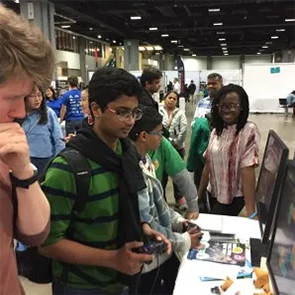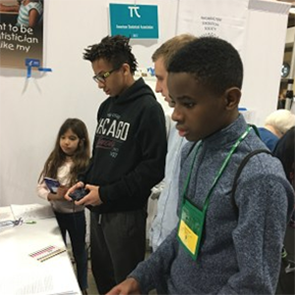To the Festival and Back: A Journey of Fun and Statistics
May 31, 2018

Yeng Saanchi, PhD Candidate
May 31, 2018

Yeng Saanchi, PhD Candidate
The Science and Engineering Festival is a biennial event that attracts numerous exhibits from people in the Science, Technology, Engineering, and Mathematics (STEM) fields and is held at the Walter E. Washington Convention Center in Washington DC. The purpose of the festival is to enlighten children, especially teens, about the great work that is being done in STEM and to engender interest in these fields.
This year, the festival took place from April 6 to April 8. A few of us from Laber Labs took a trip to DC to exhibit a computer game called Laser Foxes, which was developed by some members of the lab. The game is built primarily on a statistical concept called classification—a term used for problems that involve predicting a label from among several possible labels based on some known features.
Now to a simple description of the game. As the name suggests, the game involves two foxes shooting lasers at each other while navigating a series of blocks, where the blue fox is controlled by the human player and the orange fox is controlled by the computer. A player could adopt one of four possible strategies at any point in the game. There is the Camper, who generally stays in one place; the Aggessor, who actively seeks out his opponent; the Forager, who searches for tools within the game to aid his mission; and the Evader, who actively avoids his opponent. Throughout the course of the game, the computer, or the Artificial Intelligence (AI), adjusts his strategy to counter what it predicts the human player’s current strategy to be. This prediction is based on the observed past moves of the human player. As the game goes on, the AI gets “smarter” at predicting and responding to the human’s strategy. In effect, the AI learns to beat the human player by observing the human’s plays.
The first day of the festival was a sneak peek and was open to only middle schoolers. The turnout was great. As soon as the doors opened, busloads of children, together with their teachers, disembarked at the entrance to the convention center. It was heartwarming to see how excited the kids were to play the game and how good some of them were at beating the AI, which is quite a feat in the game of Laser Foxes. Some of the children and many of the parents were actually quite interested in the theory behind the game and thought it was really cool to be able to create a computer game using Statistics. We gave out stuffed foxes as a memento as well as information cards with details about the American Statistical Association and Laber Labs. During brief lulls in the traffic of kids waiting to play the game, some of us played the game and even managed to win at the expert level. Alas, some of us still managed to lose every game at the easy level.


Attendance on the second day was overwhelming. This time the festival was open to the public. By early afternoon, we had run out of the over one thousand stuffed animals we had brought with us. Up until the very end of the day’s session, we had children playing the game, some of whom had to be convinced by their parents that they could return the next day before they agreed to leave. In between shifts, we took in some of the sights in DC since for some of us it was our first visit. My first sight of the city of Washington DC with its primarily white-stone buildings, brought to mind Gondor, that make-believe city in Tolkien’s Lord of the Rings that was the prominent kingdom of the race of men in Middle-earth. It was impossible to see the museums because of the long queue of people waiting to enter at each one we attempted to visit. However, we managed to see the cherry blossom trees, the Lincoln Memorial, and the White House.


The third day of the festival dawned bright and clear and we were looking forward to another day of Laser Foxes with the kids. Our last day went really well. The turnout was remarkably good and the kids were as excited as ever. It was with mixed feelings that we packed up at the end of the day, sad that the festival was over but glad at the same time that for a few days we had been able to share our love of Statistics through a fun game called Laser Foxes. All in all, it was a trip to be remember!

Yeng is a PhD Candidate whose research interests include predictive modeling and variable selection. We asked a fellow Laber Labs colleague to ask Yeng a probing question.
Classic good news/bad news situation. First, the good news. You’ve accidentally been buried alive in a casket with enough air to keep you alive for three days. Now the bad news. You’re bored and need to occupy your thoughts until you suffocate so you decide to write a short story about a squirrel who befriends an anthropomorphic acorn but struggles against eating him during the long winter when food supplies are running low. Tell us that story.
Winter had lasted far longer than Mr. Toad, the squirrel, had anticipated. Ten months of snow and ice was something no one could have foreseen. “What have those infernal humans done this time to cause such a drastic imbalance in weather?”, he wondered for the umpteenth time. As he sat and contemplated this, he also wondered how he was going to survive if the weather did not warm up soon. He was down to his penultimate acorn. The last acorn happened to be a particularly fat one that he thought could last him at least a week. Three days went by and still winter persisted. Mr. Toad was now down to the shiny and seemingly delectable acorn he had saved for last. He stared at the acorn sadly, reluctant to mar its smooth surface with teeth marks, but alas, he was too hungry to resist for long. Muttering an apology under his breath, he opened his mouth to take a nibble. Just before his teeth could make contact with the acorn, he heard a squeaky voice say, “Please sir, I beg of you, don’t eat me.” To say Mr. Toad was startled would be a gross understatement. He was positively stupefied and not a little terrified. He had assumed all this while that he was the only living being in his dwelling. He knew without a doubt that the voice must have come from the acorn but it was too much. A living, breathing, talking acorn? Who had ever heard of such a thing? Not even his Grandpa Turtle, the famous squirrel who had sailed the seven seas with Captain Blood, had ever mentioned such a phenomenon. “What devilry is this”, he wondered? “Has hunger made me delusional?” After a few minutes of silence, he mustered courage and asked, “Who are you?” In a breathy, chocolaty voice, the acorn replied, “My name is Mr. Mulberry”. “How is it that you can talk?”, asked Mr. Toad. And so began the tale of how the acorn became anthropomorphic. But that is a story for another time. Suffice it to say that by the time Mr. Mulberry was done telling his tale, the ice had begun to melt. Spring had arrived! Mr. Toad and Mr. Mulberry, now fast friends, ventured outdoors for the first time in almost a year, breathing in the fresh smell of spring. The End.
This is Yeng’s second post! To learn more about her research, check out her first article here!